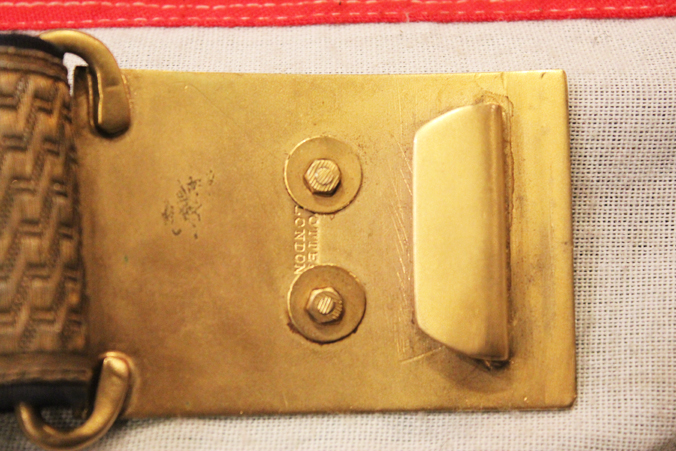A Superb Victorian Hampshire Regt. Officers Full Dress Belt and Belt Plate One of the Best Examples We Have Ever Seen
A most scarce pattern of Victorian Hampshire regimental waist belt In 24 carat gilt and gold bullion, over red Morocco leather. Very few of these beautiful quality belts survive complete, and this is a truly exceptional one. Manufactured by Potter of London. Known as the Hampshire Tigers, the buckle bears the symbols of the Indian Tiger, and the Rose plucked from the Battle of Minden. The Hampshire Regiment was formed on 1st July 1881 when The 37th (North Hampshire) Regiment of Foot and The 67th (South Hampshire) Regiment of Foot were merged as part of the Childers reforms. Portrait miniature of an officer of the 37th or North Hampshire Regiment of Foot in the gallery for reference not included
The 37th Regiment of Foot was first formed in 1702 and as was the tradition at the time named ?Meredith?s Regiment? after Thomas Meredith, the Colonel of the Regiment who raised it in Dublin. The Regiment then served in various campaigns including The War of Spanish Succession (1704-1710) and The War of the Austrian Succession (1740?1748). In 1745 The Regiment returned to England when Bonnie Prince Charlie (the grandson of the deposed James II) landed in Scotland, attempting to regain the crown lost to the Stuart family in 1688 and incited the Jacobite Rising. The Regiment fought for the Hanoverian King George II at the Battles of Falkirk and Culloden. In 1751 the Regiment became The 37th Regiment of Foot as part of a scheme to simplify the naming system of British Army Regiments. The Regiment was once again involved in foreign campaigns including, The Seven Years War (1756?1763) and The American War of Independence (1775-1783). In 1783 The 37th became The 37th North Hampshire Regiment in order to aid recruitment. The Regiment was involved in various campaigns including The Peninsular War and The First War of Indian Independence.
The 67th Regiment of Foot was initially the 2nd Battalion of the 20th Foot but detached in 1758 and became the 67th of Foot. The Regiment saw its first action on the aborted expedition to capture St. Malo in 1758. It was part of the force sent to capture Belle Isle during the Seven Years War, also served in The Spanish invasion of Portugal 1762 and was stationed in India from 1805 after the Second Anglo-Maratha War and participated in The Third Anglo-Maratha War (1817?1818), remaining in India for 21 years. In 1783 The 67th became The 67th South Hampshire Regiment in order to aid recruitment. The Regiment was further involved in foreign campaigns including The Second and Third China Wars (1857-1865) and The Japan Expedition (1862?1864).The 67th return to England after 21 years and authorisation to carry the Royal Bengal Tiger on the Regimental Colours
In February 1826, after spells in Sholapore and Poona, the regiment was sent to Rangoon to reinforce British troops engaged in the Burmese war.
Both Regiments were amalgamated in 1881 as part of the Childers Reforms and became the Hampshire Regiment. The Childers Reforms restructured the British army infantry Regiments. The newly formed Regiment engaged in various foreign campaigns including; Secunderabad (1886-1888), Burma (1888?1891), South African War (1899?1902), and two World Wars.
Code: 21180
645.00 GBP




